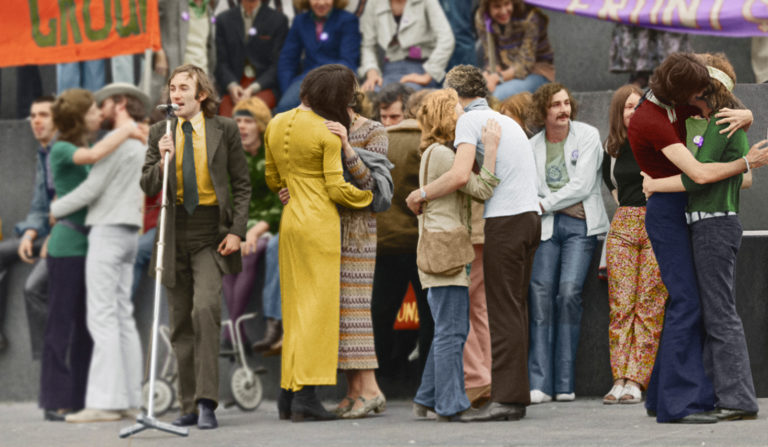

During Pride, only one rainbow deserves to be seen. That’s why SKITTLES® has given up its rainbow to re-colour moments from Pride’s history. In partnership with GAY TIMES, Switchboard and Queer Britain, the Recolour The Rainbow campaign has breathed new life into archive imagery to acknowledge and celebrate those who have come before us in the fight for LGBTQ+ liberation.
Alongside the recolouring of four black and white images, we have delved deeper into the stories of the people featured in the photographs to find out their memories of the moment, and to spotlight and preserve queer history for a new generation.
It’s London in 1971. The sound of Simon & Garfunkel’s Bridge Over Troubled Water echoes through the streets, glamorous photos of Barbara Streisand were released and her rise to gay icon status was well and truly on its way. But despite this, there is an overwhelming silence towards all things LGBTQ+. Andrew Lumsden, the man with the mustache in the photo uses the Italian word ‘omertà’ to describe it: ‘Don’t say a word, keep silent.’ Despite the changing of the Sexual Offences Act in 1967, there were still about six different laws which could negatively affect the community, Andrew explains. “Gay men were the obvious ones because there were two specific laws against sexual conduct by gay men at any age. But there were other laws to do with indecency and behavior in public which could affect anybody LGBTQ+. Lesbians suffered from that awful thing: silence.”
Through this dark period, there were moments of light. Radical drag was finding a place in the consciousness. It wasn’t the same as commercial drag; radical drag was reclaiming the right to wear any kind of clothes. “On one occasion I spent seven weeks wearing a skirt wherever I went,” Andrew recalls.
Andrew, who was 28 at the time, was not a member of the Gay Liberation Front youth group, but was asked and encouraged to come along on the day. He was due to speak after Michael Mason, the man in the picture at the microphone. “I wasn’t nervous, I’d done a lot of speaking in public at meetings,” he says. “I decided to be brief and it was something along these lines: ‘You may have often seen demonstrations in Trafalgar Square. You may have often seen demonstrations against the bomb campaign for nuclear disarmament, and you will have seen that there are always MPs up on the platform, lending their support to the campaign for nuclear disarmament and occasionally other causes. There are no MPs on this platform. There are no out MPs. You won’t see an MP on this platform.’”
The Gay Liberation Front began to change everyone’s attitudes towards LGBTQ+ people. Upon its beginnings, a manifesto was written with demands on how things could change. They did fight for their own liberation, but also the liberation of others. Through the ideals of being proud and open about who you were, you could create a ripple of change amongst those who knew you. “We often worked out that between 8 and 10 straight people’s lives would be altered by having a relative who joined the Gay Liberation Front. Unless they never heard that it had happened. But if they knew it had happened, then they learned what had been concealed from them for all previous centuries about the reality of queer people.”